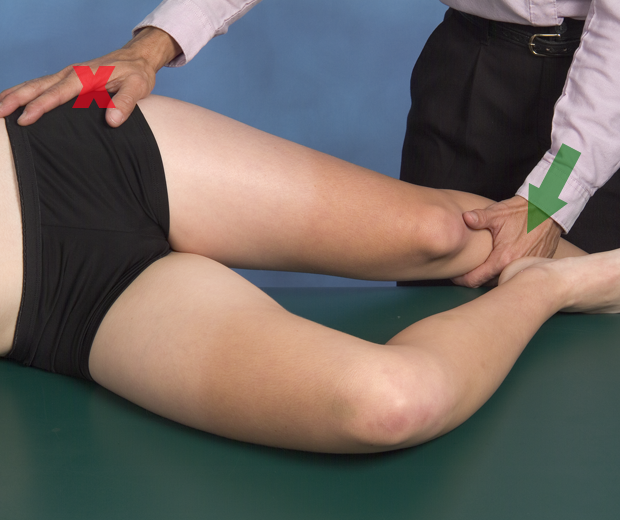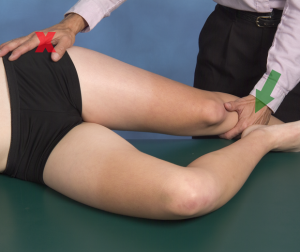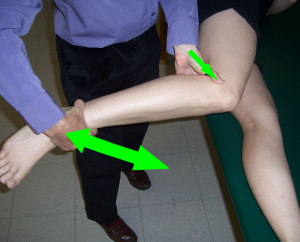Assessing ITB Tension



Assessing ITB Tension
The iliotibial band (ITB) originates from the anterolateral aspect of the iliac crest, down the lateral thigh, and the band of dense fibrous connective tissue inserts at the lateral condyle of the tibia known as Gerdy’s tubercle. Thus, it is a biarticulated structure. Position of the hip will influence the tension on the knee. Through the association with the tensor fascia latae (TFL) and some of the fibers of the gluteus maximus muscle, the ITB contributes to hip abduction and rotation as well as knee flexion and extension. The ITB also provides stabilization to the lateral knee.
The biomechanics of the ITB are interesting. During knee extension the ITB moves anterior to the lateral condyle of the femur and contributes to knee extension. When flexing beyond 30 degrees, the ITB moves posterior to the lateral condyle and contributes to knee flexion. It is at about 30 degrees of flexion when the joint motion of the ITB is transitioning that people experience clicking, snapping, and/or irritation. The task at which is most apparent is ascending/descending stairs.
Injury to the ITB occurs most commonly in cases of overuse. Running and cycling are the frequently associated activities. Tests to assess ITB flexibility, by nature of anatomy, must also assess the tensor fascia latae. In fact, attempts to “stretch” the ITB may actually be unreasonable since it is such a fibrous structure. Nonetheless, there are at least two tests to gauge the tightness/irritation of the iliotibial band: Ober test and Noble test.
 The Ober test is performed in sidelying with the involved hip superior and the pelvis stabilized. The superior lower extremity is taken into hip extension with the knee extended. The leg is then allowed to slowly drop into hip adduction. Under normal circumstances, one would expect the involved lower extremity to achieve sufficient adduction to cross midline. Failure to do so would be considered a positive test.
The Ober test is performed in sidelying with the involved hip superior and the pelvis stabilized. The superior lower extremity is taken into hip extension with the knee extended. The leg is then allowed to slowly drop into hip adduction. Under normal circumstances, one would expect the involved lower extremity to achieve sufficient adduction to cross midline. Failure to do so would be considered a positive test.
Willett et al (2016) refutes the hypothesis that the ITB plays a role in limiting hip adduction during the Ober test. Their results suggest the Ober test assesses tightness of structures proximal to the hip joint, such as the gluteus medius and minimus muscles and the hip joint capsule, rather than the ITB
 The Noble test is also used for the ITB but it is geared towards evaluating the degree of irritability (ITB syndrome) not tightness. To administer this test, the ITB is appraised distally at the knee. As stated, the ITB is involved in both flexion and extension of the knee. With the attachment at Gerdy’s tubercle, the ITB is aligned in front of the knee axis of motion when the knee is in full extension, thus contributing to extension (0-30 degrees). When the knee is flexed beyond 30 degrees, the ITB is pulls posterior to the knee axis of motion and contributes to knee flexion (30-135 degrees). That being said, the testing process uses the 30 degree knee flexion point as the key to rating irritability. In sidelying on the uninvolved leg, the involved hip is placed in extension and the knee in flexion. The clinician places his/her thumb over the lateral femoral condyle. Pressure is applied while flexing and extending the knee through the 30 degree angle. As this motion occurs, the ITB will translate anterior over the femoral epicondyle with extension and posterior with flexion. If pain or clicking is reproduced with this translation, the test is considered positive.
The Noble test is also used for the ITB but it is geared towards evaluating the degree of irritability (ITB syndrome) not tightness. To administer this test, the ITB is appraised distally at the knee. As stated, the ITB is involved in both flexion and extension of the knee. With the attachment at Gerdy’s tubercle, the ITB is aligned in front of the knee axis of motion when the knee is in full extension, thus contributing to extension (0-30 degrees). When the knee is flexed beyond 30 degrees, the ITB is pulls posterior to the knee axis of motion and contributes to knee flexion (30-135 degrees). That being said, the testing process uses the 30 degree knee flexion point as the key to rating irritability. In sidelying on the uninvolved leg, the involved hip is placed in extension and the knee in flexion. The clinician places his/her thumb over the lateral femoral condyle. Pressure is applied while flexing and extending the knee through the 30 degree angle. As this motion occurs, the ITB will translate anterior over the femoral epicondyle with extension and posterior with flexion. If pain or clicking is reproduced with this translation, the test is considered positive.
The only statistical data identified in the literature for these two tests is reliability (ICC) of 0.80 – 0.974 for the Ober test.
 For videos of these techniques or more cutting-edge orthopedic information please subscribe to iOrtho+ Premium Web App. Prior blog posts and learning modules can be found at https://iortho.xyz/
For videos of these techniques or more cutting-edge orthopedic information please subscribe to iOrtho+ Premium Web App. Prior blog posts and learning modules can be found at https://iortho.xyz/
- Gautam VK, Anand S: A new test for estimating iliotibial band contracture, Journal Bone Joint Surgery British 1998;80:474-475
- Gulick DT. iOrtho+ Mobile App. DTG Enterprises LLC. 2020
- Gulick, DT. OrthoNotes, 4th FA Davis Publishing, Philadelphia. 2018
- Melchione W, Sullivan S. Reliability of measurements obtained by use of an instrument designed to measure iliotibial band length indirectly. Journal Orthopedic & Sports Physical Therapy. 1993;18:511-515
- Noble HB, Hajek MR, Porter M: Diagnosis and treatment of iliotibial band tightness in runners, Physician Sportsmedicine 1982;10:67-68, 71-72, 74
- Ober FB: The role of the iliotibial and fascia lata as a factor in the causation of low-back disabilities and sciatica, Journal Bone Joint Surgery 1936;18:105-110
- Reese N, Bandy W. Use of an inclinometer to measure flexibility of the iliotibial band using the Ober test & Modified Ober test. Journal Orthopedic & Sports Physical Therapy. 2003;33:326-330
- Willett GM, Keim SA, Shostrom VK, Lomneth CS. An Anatomic Investigation of the Ober Test. American Journal of Sports Medicine. 2016;44(3):696-701
